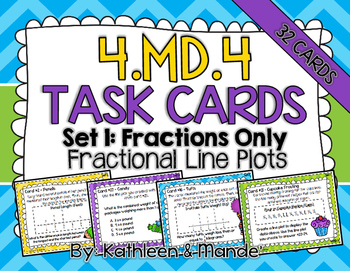4.MD.4 Task Cards: Fractional Line Plots {Set 1: Fractions Only}
- PDF
- Easel Activity
What educators are saying
Also included in
- This CCSS aligned bundle has everything you need to teach 4.MD.4: Fractional Line Plots. By purchasing the bundle, you can save 15%! WOW! Click each link below to see each product's detailed description and preview.- - - - - - - - - - - - - - - - - - - - - - - - - - - - - - - - - - - - - - - - - - -Price $12.30Original Price $14.50Save $2.20
- Teaching measurement and data? Grab this MEGA bundle with everything you need to teach all of your 4.MD standards. Each standard below can be purchased as an individual bundle (click link) at a 15% savings. When you purchase this MEGA bundle you save even more....20%!What's included? These 36 awesomPrice $71.00Original Price $89.50Save $18.50
- Get all of our best selling task card sets in one download! This product includes 32 task card sets in all....That's over 900 task cards! WOW! Save over 10% when purchasing this bundle!Poster Sets are included for the following standards:**Numbers and Base Ten Operations**4.NBT.1-2: Place Value4.NBTPrice $75.00Original Price $89.75Save $14.75
Description
Looking for a fun, engaging way for your students to practice creating and interpreting fractional line plots? Your students will love practicing with these adorable, easy to use task cards. These 32 task cards are aligned to CCSS 4.MD.4: Fractional Line Plots.
Do you want to assess the quality of our task cards before you buy?
Try our {FREEBIE} 4.NF.7 Task Cards: Compare & Order Decimals.
- - - - - - - - - - - - - - - - - - - - - - - - - - - - - - - - - - - - - - - - - - - - - - - - - - - - - - - - - - - - - - - - - - -
This is Set 1 of our fractional line plot task cards. Only fractions are used in these task cards. Once students have mastered line plots with fractions, they are ready for Set 2: Fractional Line Plots with Mixed Numbers.
Be sure to check out our other 4.MD.4 resources:
4.MD.4 Practice Sheets: Fractional Line Plots {18 sheets}
4.MD.4 Assessment: Fractional Line Plots {2 Assessments}
4.MD.4 Matching Cards: Fractional Line Plots
…....or purchase one of our bundles and SAVE $$$!
Save 10%....4th Grade Math Task Card Bundle!
Save 15%....4.MD.4 Bundle!
Save 20%...4.MD **MEGA** Bundle - All Measurement & Data Standards!
- - - - - - - - - - - - - - - - - - - - - - - - - - - - - - - - - - - - - - - - - - - - - - - - - - - - - - - - - - - - - - - - - - -
There are 32 task cards in all. A recording sheet and answer key are provided.
- Cards 1-16: A line plot is provided.
- Cards 17-32: Students will create a line plot given data.
Cards ask students to interpret the data presented:
- Which is the most common? Least common?
- What is the difference between the biggest and smallest data?
- What is the difference between the smallest and most common data?
- How many more are _____ than _____?
- What is the combined length/weight of all objects?
***Cards are both open response and multiple choice format.
The 4.MD.4 standard is great to teach after students have mastered 4.NF.1, 4.NF.2, 4.NF,3, and 4.NF.4. Students will need to apply their knowledge of fractions to answer these task card questions. Need resources for 4.NF.1-4? Click the links below:
4.NF.1 & 4.NF.2 BUNDLE: Equivalent and Comparing Fractions
4.NF.3 & 4.NF.4 BUNDLE: Adding, Subtracting, & Multiplying Fractions
These task cards can be used:
•Whole class (use one at a time to promote discussion)
•Scoot
•In math stations (allowing students the opportunity to discuss their answers and reasoning with a partner or group)
•Individually as an assessment
•Review (whole class, individually, or groups to review for standardized testing)
•As game cards (used with any board game)
We hope you and your students enjoy these!
Teaching Together,
Kathleen & Mande’









